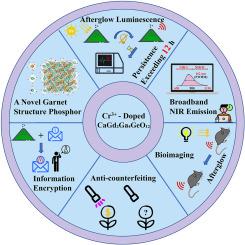Structure, near-infrared broadband luminescence and long afterglow properties in CaGd2Ga4GeO12: Cr3+ garnet phosphor for multifunctional applications
IF 3.6
3区 物理与天体物理
Q2 OPTICS
引用次数: 0
Abstract
Near-infrared (NIR) long persistent phosphors (LPPs) have recently gained a lot of attention due to their significant potential in applications like information encryption, in vivo bioimaging, and military technologies. Nonetheless, the significant reduction in their brightness and duration to be a major issue. Consequently, the development of LPPs with enhanced luminescence intensity and prolonged duration is of great importance. In this study, we present a new near-infrared (NIR) luminescent phosphor particle (LPP), specifically CaGd2Ga4GeO12: Cr3+ (CGGG: Cr3+). Under the irradiation of 448 nm blue light, the CGGG: Cr3+ phosphors displays a larger full width at half maximum (FWHM) of 162 nm for emission. Following 5 min irradiation with 254 nm ultraviolet light, the instrument remained capable of detecting near-infrared emission signals after a 12 h interval. A detailed investigation was carried out on the crystal structure, electronic structure, thermal stability, luminescence characteristics, and afterglow behavior of this phosphor material. Moreover, an in-depth investigation into the mechanism of NIR LPPs was undertaken. Through thermoluminescence emission curve analysis, the trap distribution range in CGGG:Cr3+ was also evaluated. In summary, these findings suggest that CGGG:Cr3+ phosphor holds significant promise as a persistent near-infrared light-emitting material for advanced light source applications, including bio-imaging and information encryption.

多功能CaGd2Ga4GeO12: Cr3+石榴石荧光粉的结构、近红外宽带发光和长余辉特性
近红外(NIR)长持久性荧光粉(LPPs)近年来因其在信息加密、体内生物成像和军事技术等方面的巨大应用潜力而受到广泛关注。尽管如此,它们的亮度和持续时间的显著降低将是一个主要问题。因此,开发发光强度增强、持续时间延长的LPPs具有重要意义。在这项研究中,我们提出了一种新的近红外(NIR)发光荧光粉粒子(LPP),具体为CaGd2Ga4GeO12: Cr3+ (CGGG: Cr3+)。在448 nm蓝光照射下,CGGG: Cr3+荧光粉的发射半峰宽(FWHM)为162 nm。在254 nm紫外光照射5 min后,仪器在间隔12 h后仍能检测近红外发射信号。对该荧光粉材料的晶体结构、电子结构、热稳定性、发光特性和余辉行为进行了详细的研究。此外,对近红外LPPs的机理进行了深入的研究。通过热释光发射曲线分析,评价了CGGG:Cr3+中的陷阱分布范围。综上所述,这些发现表明CGGG:Cr3+荧光粉作为一种持久的近红外发光材料,在先进的光源应用中具有重要的前景,包括生物成像和信息加密。
本文章由计算机程序翻译,如有差异,请以英文原文为准。
求助全文
约1分钟内获得全文
求助全文
来源期刊

Journal of Luminescence
物理-光学
CiteScore
6.70
自引率
13.90%
发文量
850
审稿时长
3.8 months
期刊介绍:
The purpose of the Journal of Luminescence is to provide a means of communication between scientists in different disciplines who share a common interest in the electronic excited states of molecular, ionic and covalent systems, whether crystalline, amorphous, or liquid.
We invite original papers and reviews on such subjects as: exciton and polariton dynamics, dynamics of localized excited states, energy and charge transport in ordered and disordered systems, radiative and non-radiative recombination, relaxation processes, vibronic interactions in electronic excited states, photochemistry in condensed systems, excited state resonance, double resonance, spin dynamics, selective excitation spectroscopy, hole burning, coherent processes in excited states, (e.g. coherent optical transients, photon echoes, transient gratings), multiphoton processes, optical bistability, photochromism, and new techniques for the study of excited states. This list is not intended to be exhaustive. Papers in the traditional areas of optical spectroscopy (absorption, MCD, luminescence, Raman scattering) are welcome. Papers on applications (phosphors, scintillators, electro- and cathodo-luminescence, radiography, bioimaging, solar energy, energy conversion, etc.) are also welcome if they present results of scientific, rather than only technological interest. However, papers containing purely theoretical results, not related to phenomena in the excited states, as well as papers using luminescence spectroscopy to perform routine analytical chemistry or biochemistry procedures, are outside the scope of the journal. Some exceptions will be possible at the discretion of the editors.
 求助内容:
求助内容: 应助结果提醒方式:
应助结果提醒方式:


